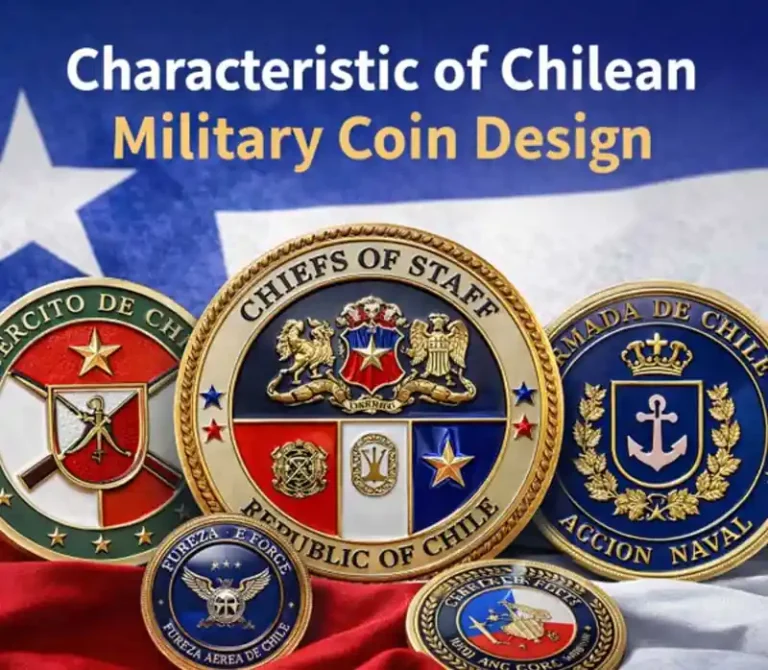
Merkmale des militärischen Designs chilenischer Münzen
Table of Contents Chile’s armed forces, the Ejército de Chile (Army), Armada de Chile (Navy), and Fuerza Aérea de Chile
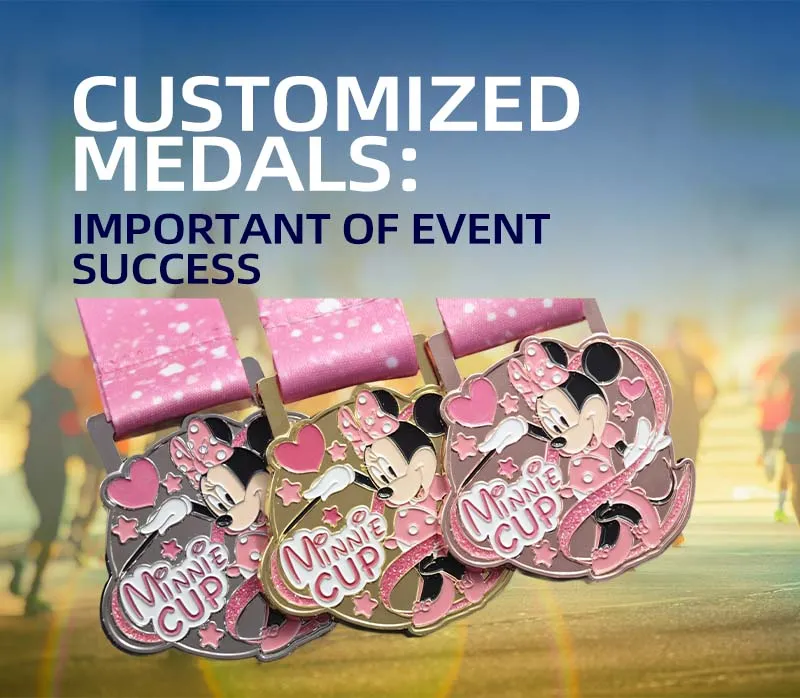
Customized finisher medals – uniquely designed awards given to all finishers or participants – have become a hallmark of many modern sports events, especially mass-participation races.
Beyond mere keepsakes, these medals are often seen as incentives that can influence an event’s popularity und participation levels.
This report examines how offering individuelle Medaillen correlates with increased attendance and engagement at sports events.
We draw on surveys, expert opinions, and case studies (primarily from running events) to explore whether the promise of a special medal can boost an event’s success in terms of participant numbers and overall appeal.
Event organizers increasingly treat finisher medals as a key marketing asset.
In an era of plentiful races and competitions, a distinctive medal can differentiate an event from its competitors. As one industry expert noted, road races now even hold medal unveilings and release elaborate preview videos months in advance, using the medal design in their recruiting efforts.
Dan Ashworth, CEO of a major medal manufacturer, observed that medals have become “the most important piece of marketing” for many races – effectively a part of the marketing budget. Some races have gone so far as to establish a “National Finisher’s Medal Day” to celebrate these mementos, underscoring how ingrained medals are in event promotion.
A creative or high-quality medal can generate buzz and word-of-mouth. Participants often share photos of their medals on social media, which serves as free advertising for the event. For example, one organizer noted that after introducing a multi-race “puzzle” medal series, runners eagerly posted pictures of the medals online, prompting others to ask “How do I get that?”. In this way, unique medals not only reward finishers but also become conversation pieces that raise an event’s profile and attract future participants.
There is growing evidence – both statistical and anecdotal – that offering attractive individuelle Medaillen can boost participation numbers.
While many factors affect an athlete’s decision to register for an event, Finisher-Medaillen do play a role for a significant segment of participants.
In earlier surveys, roughly one-third of runners (about 36%) said that receiving a medal was an important factor in choosing which races to run.
More recent data from the 2022 Running USA Global Runner Survey (covering thousands of runners) found that about 16% listed the medal/finisher award as a reason for selecting an event.
This places medals below factors like distance, date, location and course quality as top considerations, but it is still notable that roughly one in six runners worldwide explicitly weigh the medal when deciding on an event.
The chart below illustrates how medals compare to other event choice factors among runners.
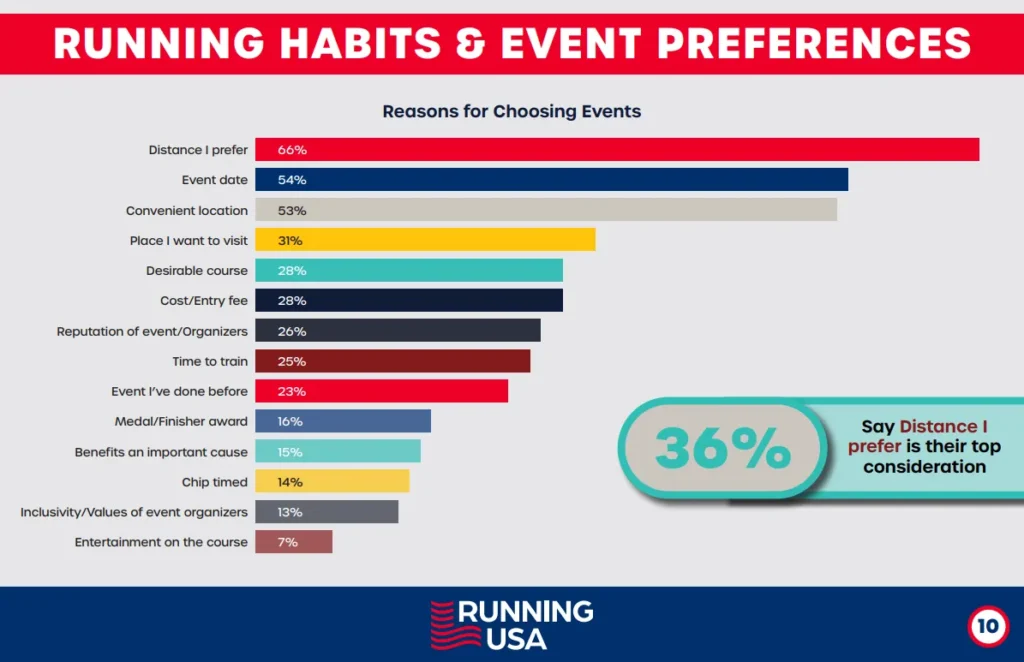
Crucially, for some events the medal can be a difference-maker in registration numbers.
A striking case is the Philadelphia Marathon and its famed Liberty Bell medal.
For the marathon’s 25th anniversary, organizers had introduced a large 3D Liberty Bell finisher medal that actually rings.
The medal was so popular that when it was dropped in 2016 in favor of a different design, “the number of runners who signed up for the race declined,” according to the executive director of the race.
Runners repeatedly asked if the Liberty Bell design would return, and organizers – surprised by the outcry – decided to bring back that custom medal due to popular demand.
This suggests a causal link: the absence of a coveted medal coincided with lower participation, and restoring it was viewed as necessary to revive enthusiasm.
As the race director succinctly put it, in today’s crowded market “runners are coming to expect something special [in the medal]… if they don’t get it, that’s okay. But if they do, that’s better.”
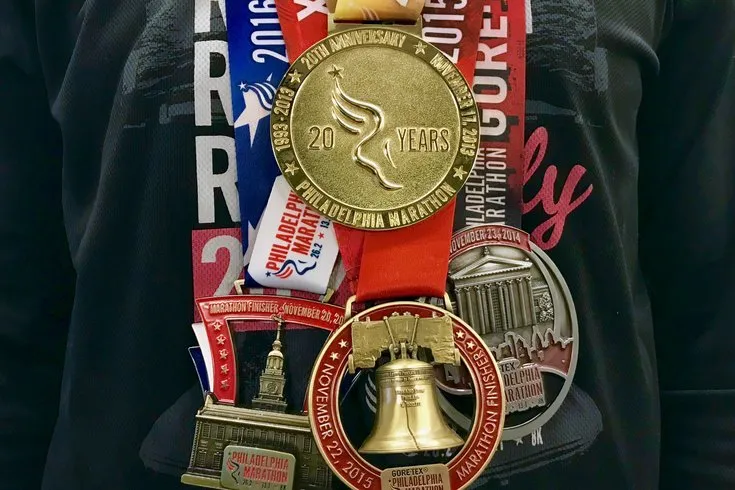
Other race organizers echo the idea that “the better the bling, the more runners you attract.”
Brie Burdych of Corrigan Sports, which manages a series of races, explains that when runners plan their race calendar, offering an extra medal or a more impressive design can sway them: “If we put this extra medal out there and grab them early, we figure they’ll sign up for our races rather than somebody else’s.”
In Rhode Island, a series of five half-marathons introduced interlocking medals (each race’s medal was a magnetized puzzle piece that combined into one giant medallion when all five were earned).
The result: significantly more runners were motivated to do all five events in order to collect the full set.
“We found that it made more people want to do all five races,” said Susan Rancourt, the series co-owner, adding that “the medal is a huge part of that—probably the biggest part of it.”
This is a clear case where offering a creative medal incentive led to higher participation across multiple events (increasing repeat registrations and event-to-event loyalty).
Even single races have seen growth by enhancing their medals.
The Little Rock Marathon, for example, gained national notoriety for its enormous, whimsical finisher medals (weighing several pounds and featuring themes like dragons and space aliens).
Little Rock’s ever-bigger medals have created a devoted following of runners who travel to Arkansas specifically for the medal experience.
Similarly, runDisney races (e.g. the Disneyland Half Marathon) and the Nike Women’s Marathon became famed for their unique finisher prizes – a Mickey Mouse medal and a Tiffany & Co. necklace, respectively – which many runners cited as a major draw, even outweighing the cost or travel inconvenience of those events.
In short, a distinctive Medaille can elevate an event’s must-do appeal, translating into higher registration counts and sold-out races.
From the organizers’ perspective, investing in a great medal often pays for itself by boosting participation.
Leo Dignam, Philadelphia Marathon’s director, noted that medals typically cost a few dollars each wholesale.
Even if a higher-quality custom medal costs a bit more, attracting just a few hundred extra registrations can cover the expense: “If your medal’s going to cost 50 cents more but you get 1,000 extra runners at $150 apiece, it pays for itself,” Dignam explains.
This calculus demonstrates why many event directors view medals as a smart investment to increase attendance. Dignam also mentioned that during recruitment season, one of the most common questions from prospective runners is about the finisher medal – indicating how closely participation decisions can be tied to medal expectations.
It’s worth noting that not every participant cares about medals to the same degree – for some it’s essential, for others negligible.
For instance, at Washington DC’s Cherry Blossom Ten Mile Run, organizers made the Finisher-Medaille optional (runners could choose to pay an extra $15 for a medal or save money by forgoing it).
Only about one-third of participants opted to buy the medal, suggesting a majority were willing to race without any medal. However, a full one-third paying extra for a medal is still significant;
it represents a substantial revenue stream and underscores that a large subset of runners tun value the medal highly.
This dual behavior — some runners indifferent, others highly motivated by medals — aligns with the survey data above and highlights why offering a medal can capture the interest of those medal-motivated participants without alienating others (some events, like Cherry Blossom, solve it by making medals optional).
Beyond sheer numbers, customized medals contribute to an event’s popularity and participant satisfaction in less tangible ways.
Finishers often report that medals provide a sense of accomplishment and a “badge of honor” they can show off with pride.
Many athletes display their medals at home or even wear them around post-race, which in turn raises the event’s visibility in the community. This pride-by-association can enhance an event’s reputation — a race known for a cool medal can develop a positive image among target participants.
Social media has amplified this effect.
As noted, runners frequently post photos of themselves with their medals, effectively broadcasting the event to friends and followers.
A photogenic or unusually clever medal design can go viral in running groups.
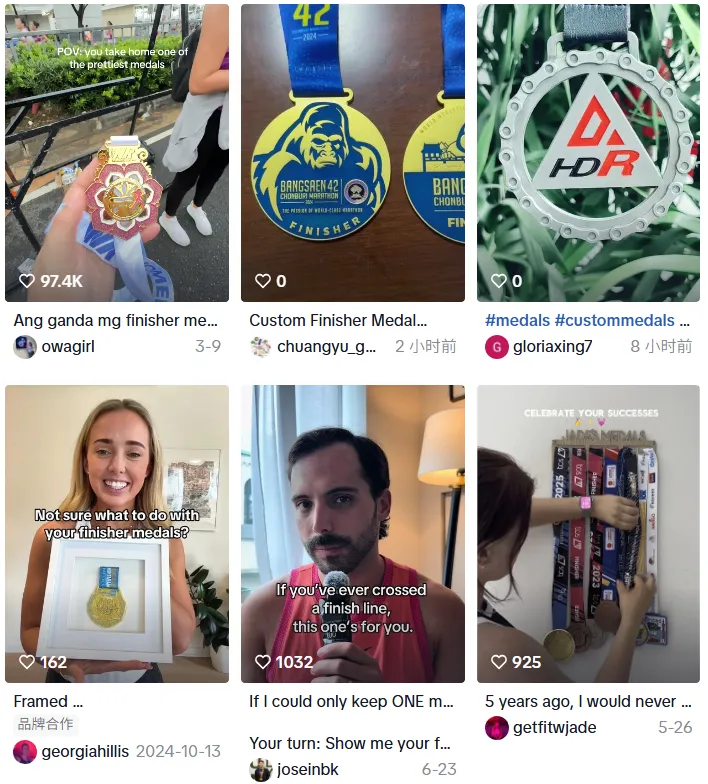
Race directors deliberately capitalize on this: by creating medals that people want to photograph and share, they turn finishers into ambassadors for the event.
The Rhode Island puzzle medal case showed how social sharing led to FOMO (“fear of missing out”) among those who hadn’t run, driving more interest the next year.
In other words, medals can fuel a virtuous cycle: they reward current participants and simultaneously entice future participants through peer influence.
Customized medals also tie into the broader experience economy around sports events.
Participants today often seek a memorable experience, not just a timed result. A unique medal can serve as a tangible memory of that experience, increasing overall satisfaction.
Industry surveys have indeed found that “one of the most important things to runners is the bling,” according to race merchandise managers who study participant feedback.
This doesn’t mean runners only care about medals, but it does imply that many view a quality medal as an integral part of a great event experience.
An event that skimps on or ignores the finisher medal could be perceived as less festive or rewarding, potentially hurting its popularity over time relative to events that provide that extra bit of celebratory recognition.
That said, there are voices cautioning about an “arms race” of medal one-upmanship.
Some traditionalists argue that too much focus on medals (and ever-more-elaborate designs with glitter, lights, moving parts, etc.) might drive up costs and detract from the pure sport.
There is also the consideration of rising entry fees – fancy medals aren’t free, and often the cost is built into registration.
For now, however, most evidence suggests that participants appreciate the added value.
In the words of a longtime race director reminiscing about the past: “People now expect these medals” as a normal part of the experience.
Meeting that expectation has, for many events, correlated with maintaining or growing their entrant numbers in a competitive environment.
To directly compare events with vs. without custom medals, consider similar races or scenarios:
Multi-Race Challenges: Events that create medal-incentive challenges (such as series medals or extra “challenge” medals for completing multiple races) often see increased participation across the board. A comparison within the Rhode Island half-marathon series (before vs. after introducing the puzzle medals) showed a clear uptick in the number of runners who completed all races in the series. Similarly, the popular Rock ‘n’ Roll Marathon Series introduced a “Heavy Medal” program (special medals for doing multiple Rock ‘n’ Roll races in one year) – this has encouraged runners to travel to and enroll in more races than they otherwise might, boosting attendance at each event in the series. In contrast, events without any such incentives typically rely on one-off local turnout and don’t see the same cross-event loyalty. The comparative lesson is that medal incentives can transform casual participants into repeat participants, increasing numbers across multiple events.
In summary, when comparing events that offer custom medals to those that don’t, the medal-bearing events tend to have advantages in attracting participants and generating excitement.
While medals alone won’t rescue a poorly organized event, in situations of all else being equal (similar date, distance, location, cost), the event with the more attractive medal package is likely to appear more popular and draw more sign-ups.
This is supported by both the qualitative testimonies of race directors (“The better the bling, the more runners you attract”) and the quantitative preferences expressed by participants in surveys.
Custom finisher medals have proven to be more than just souvenirs – they are strategic tools that can enhance the success of sports events.
Studies and industry surveys indicate that a notable portion of participants take medals into account when choosing events, and numerous case studies back up a positive correlation between offering distinctive medals and seeing increased participation or loyalty.
Events with coveted medal designs often generate extra buzz, attract repeat entrants, and sometimes even command higher entry fees due to the added perceived value. As the running industry saying goes, “Runners run for the bling”, hinting at the motivational power these shiny rewards hold.
It’s important to recognize that medals are one of several factors contributing to an event’s popularity – factors like course quality, location, organization, and cost still rank higher on average.
A well-designed medal cannot compensate for major flaws in an event. However, given two events of similar caliber, the one offering a unique, high-quality medal is likely to have an edge in drawing participants.
In competitive event markets (e.g. cities with many races or leagues), a custom medal can be the deciding factor that tips the balance in favor of one event over another.
The causal relationship can be observed in examples like the Philadelphia Marathon’s registration dip when a beloved medal was removed and the surge of interest when special medal challenges are introduced.
While more formal research could quantify this impact further, the consensus among experts and organizers is clear: offering customized medals tends to increase attendance and enhance event popularity.
Medals provide participants with a tangible sense of achievement and create emotional attachment to the event, fostering loyalty and word-of-mouth promotion.
In short, a medal can encapsulate the entire event experience in one object – and when that object is compelling, it can indeed make a meaningful difference in how successful a sports event becomes.

Table of Contents Chile’s armed forces, the Ejército de Chile (Army), Armada de Chile (Navy), and Fuerza Aérea de Chile
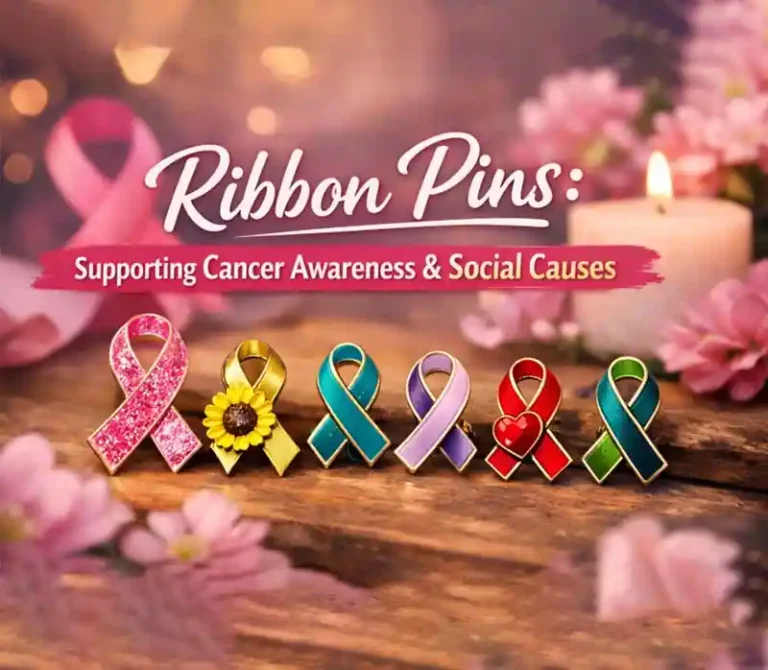
Table of Contents This guide is for anyone interested in using ribbon pins to support causes, from individuals to organizations.
Nr. 5, Tongan Road,
Ostbezirk Xiaolan Town,
Zhongshan, Guangdong,
China
Urheberrecht © 2024, Zhongshan Peakeen Gifts Supply Chain Co., Ltd. Alle Rechte vorbehalten. Angetrieben von PeaKeen Datenschutzerklärung
Lassen Sie uns zusammenarbeiten, um Geschäftswachstum zu erzielen!
Lassen Sie uns zusammenarbeiten, um Geschäftswachstum zu erzielen!
10% Aus